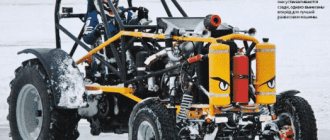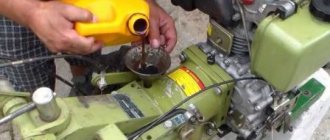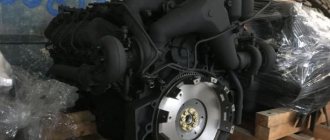As a rule, in winter, many car owners experience certain difficulties associated with starting a cold car engine. In other words, it is impossible to start the engine quickly, after several unsuccessful attempts the battery is discharged, etc.
At the same time, certain techniques that should be used when trying to start a power unit in cold weather do not always help. We are talking about briefly turning on the headlights to “revive” the battery, about “blowing out” the cylinders so that the spark plugs do not flood and the load on the starter is reduced, as well as other ways to achieve a quick and reliable start of a cold engine.
In such a situation, when a cold engine does not start, various means and methods come to the rescue. Some drivers use solutions for pre-heating the internal combustion engine, others try to replenish the battery charge using starting chargers, and still others resort to auto chemical products. Next we will talk about what a “quick start” aerosol is and how it works, as well as what pros and cons such a solution has.
How do you know when it's time to use Quick Start?
Is the frost below 20 degrees outside?
Then there is a chance that you will have to do a little magic with the machine to get it running. Each tool must be used wisely, and before you begin third-party interference with the operation of the standard components of the car, you need to logically exclude options that definitely do not prevent the engine from starting.
- Do the headlights shine well and does the starter turn? Crossing out a dead battery!
- Is seasonal oil of the required thickness added? We don’t consider him a weak link either.
- Remember the last time you changed the spark plugs. If it's recently, it's not them.
- Have you refueled with winter fuel if you have a diesel engine? Then we cross that out too.
If everything is so, then the bottom line is the idea that the required proportion of the air-fuel mixture is not formed. To correct the balance somewhat, you can resort to a quick start. It is more highly volatile, flammable and should help the engine start easier.
Quick start of the car engine
In winter, it often happens that you cannot start the engine the first time.
We have already written on Vodi.su about this.
Also, any driver knows that when the ignition is turned on and the starter is cranked, a large load falls on the battery and the starter itself. Cold starting leads to rapid engine wear. In addition, you have to warm up the engine for some time, and this leads to increased consumption of fuel and engine oil.
Products such as “Quick Start” are very popular in winter, making it much easier to start the car. What is this product and how does it work?
Is Quick Start harmful to your car's engine?
“Quick Start” - what is it, how to use it?
This product is intended to facilitate engine starting at low temperatures (down to minus 50 degrees), as well as in conditions of high humidity and sudden temperature changes. In a humid climate, it often happens that moisture settles on the contacts of the distributor or on the electrodes of the battery, and accordingly, the voltage sufficient to cause a spark is not generated - “Quick Start” will help in this case too.
In terms of its composition, it is an aerosol containing ethereal, flammable substances - diesters and stabilizers, propane, butane.
These substances, entering the fuel, ensure its better flammability and more stable combustion. It also contains lubricating additives, which virtually eliminate friction when starting the engine. Using this tool is quite simple.
We recommend reading: Amnesty 2022 in Uzbekistan
First you need to shake the can well several times.
What is a quick start anyway? What does it consist of?
When compared to everyday situations, a quick start can be compared to fire starter fluid. That is, a highly flammable product that helps the fuel mixture burn better.
Manufacturers use different components, but in most cases different ethers are used: for example, diethyl ether or petroleum ether. The composition may also include gases such as propane-butane or heptane. However, the basic principle of operation remains the same - to provide the first flashes of the fuel-air mixture, set the pistons in motion and warm up the combustion chamber and spark plugs.
Which composition is best to choose to make it easier to start the engine?
Manufacturers of aerosols of this type are constantly creating various unique formulations in order to minimize all risks and at the same time attract the buyer. Although the choice of such “quick start” solutions is quite wide, it is worth highlighting the offers from Liqui Moly.
The composition is intended for gasoline and diesel engines. By the way, for diesel engines it is necessary to turn off glow plugs, heated flanges, etc. before use. The throttle should be in the maximum open position (the gas pedal is pressed all the way).
Also, in addition to Liqui Moly, Mannol Motor Starter, Hi-Gear means for quickly starting the engine, etc. should be highlighted. There are other solutions on the market, but as practice shows, it is better to give preference to well-known brands.
Even before purchasing, you need to pay attention to which internal combustion engine this or that composition is intended for. Solutions can be combined, involving use only in gasoline or diesel units, two-stroke, four-stroke, etc.
Sounds scary - won't I kill the engine?
To paraphrase popular wisdom, you can foolishly break a lot of things. Therefore, it is important to know when to stop and always read the instructions for use.
Some manufacturers write that you need to spray directly into the air filter, others say that the filter needs to be removed. Opinions also differ on the duration of spraying - from 1-2 seconds to 5-6. The fact is that the composition of each manufacturer’s quick start varies in proportions and if you spray too much of the product, then there is a high probability of malfunctions. If you overdo it, the piston rings may become deformed and the valves may burn out.
It is important to choose the least harmful but effective means, because if you use pure ether as a quick start, there is a high probability of washing off the oil film from the cylinder walls. This is fraught with scuffing and increased engine wear. Therefore additives. For example, ASTROhim's quick start in the form of an aerosol contains lubricating components that eliminate disadvantages such as blurring the oil film, and the high ether content in the composition helps to start the car even in severe frosts. There is another big plus of this drug - the performance of the aerosol itself. The fact is that in cold weather the pressure in the cylinder, as a rule, drops, that is, at the right time you simply will not be able to use the aerosol. “Astrokhimovsky” is a quick start in full combat readiness down to -30 degrees. Take note.
Is it possible to start a diesel engine from a tugboat?
It is not recommended to start diesel engines in this way for several reasons. When you try to start a diesel engine “from the pusher,” the torque from the drive wheels is transmitted through the transmission to the crankshaft. ... That is why a diesel engine should only be started with a starter, but not “from the pusher”.
Interesting materials:
When to plant cabbage seedlings in the Urals? When to plant cabbage seedlings in Krasnoyarsk? When to plant watermelon seedlings? When to plant pumpkin and zucchini seedlings? When to plant pepper seedlings in 2020 in Siberia? When to plant pepper seedlings in 2022? When to plant pepper seedlings in 2022? When to plant petunias for seedlings? When to plant petunia seedlings in 2022? When to plant Petunia for seedlings?
Liquid Mannol "Motor Starter 9669"
The product, produced by a German manufacturer, is a popular and proven product. Thanks to the composition, it is possible to quickly start the engine in winter with minimal side effects. The liquid is economical and easy to use, equipped with a long tube that facilitates access to the installation. Area of application of the liquid: four-stroke engines running on gasoline, diesel, gas. In comparison with the previous product, the minimum temperature of use is -20 degrees, the product is placed in a cylinder with a volume of 450 ml (article 2136).
Engine fluid “Motor Starter 9669”:
Can “Quick Start” be used with a diesel engine?
The question that interests owners of cars with diesel engines is whether quick start fluid is suitable for them. Not all manufacturers of such compositions indicate in the instructions the possibility of using the liquid on a diesel engine. This is due to the fact that diesel fuel ignites due to high pressure. And the “Quick Start” liquid consists of esters, which have an ignition pressure significantly lower than diesel fuel. Accordingly, if you fill this liquid, ignition will occur much earlier than provided for by the engine design, which can harm the condition of the piston group and other engine components.
Operating principle of “Quick start” for the engine
The liquid, which is used to quickly start the engine in winter, visually represents an aerosol placed in a can. The volatile substance contains: propane, butane, flammable ethers, alcohols, stabilizers and other additives. In addition, lubricants are added to the mixture, which eliminate the friction of the piston rings on the dry cylinder surface. The liquid introduced into the chamber gives the fuel present there an even greater ability to ignite.
The contents of the can can activate the power motor in conditions of fifty degrees below zero. Another feature is the stabilization of the combustible properties of fuel in humid climates or sudden temperature changes. In such conditions, condensation accumulated on electrical equipment does not allow the spark plugs to develop the necessary power so that the required charge is formed and the engine cannot be started without liquid.
Negative effects of “Quick Start” on the engine
By provoking an ignition, there is a high probability of seriously harming the car engine. The “Quick Start” product has a greater ability to detonate; accordingly, with early ignition of this mixture, there is a serious dynamic impact on the engine elements, especially on the piston. Depending on the quality of the engine components, the consequences of such an impact may vary.
There are several problems that can result from regular use of “Quick Start” liquid:
Possibility of piston bending as a result of impact;- Deformation, damage or rupture of piston rings;
- Burnout of valves due to high temperatures;
- Reduced oil performance due to a possible “conflict” of chemical elements in the lubricant component and the “Quick Start” fluid;
- Potential engine overheating and thermal deformation of parts.
Experts recommend not using Quick Start liquid on a regular basis. It is best used in emergency situations when starting the engine is difficult due to low temperatures or as a result of the car being idle for a long time.
( 149 votes, average: 4.55 out of 5)
Everything about automatic transmission oil: is it necessary to change it, how to check it, what kind to fill and when to fill it?
Litol 24 lubricant: characteristics and use on a car
Related Posts
Where to add “Quick Start” liquid
The “Quick Start” compound is added to the intake manifold. Depending on the composition of the liquid and the manufacturer, the instructions for using the liquid may differ, so it is important to familiarize yourself with it - it is printed on the bottle with the composition. To summarize, we can say that when using the “Quick Start” liquid, you need to perform the following sequence of actions:
- Shake the container with “Quick Start” liquid for 10-15 seconds. This is necessary because inside the cylinder the composition is stratified into heavy and light liquids. It is important to bring the liquid to a uniform consistency;
- Next, the liquid is injected into the intake manifold. In this case, the injection duration should be no longer than 2-3 seconds;
- After this, you can immediately start the engine - it should start without problems.
Article on the topic: Why the cigarette lighter in the car does not work: causes of failure and repair
Important: If “Quick Start” did not help start the engine the first time, you can try using the composition a second time. If on the second attempt the additive does not have the desired effect, most likely there are significant problems with the ignition - you need to diagnose the starting system, spark plugs and electrical equipment.
Why add “Liquid Start”
As noted at the beginning of the article, the “Liquid Start” composition is, first of all, needed to eliminate difficulties when starting in the cold season, which are caused by:
- High viscosity oil. At low ambient temperatures, the oil becomes more viscous, making it more difficult to start the engine. Viscous oil moves more slowly along the lines, which is why the rubbing parts are not sufficiently lubricated and do not have normal sliding, that is, they work with increased wear;
- Low battery voltage. Due to insufficient voltage, difficulties arise in starting the engine, since the starter cannot spin the flywheel to the required speed;
- Condensation on contacts. Due to the formation of condensation on various contacts at low temperatures, difficulties arise in the formation of a spark between the electrodes of the spark plug.
It is precisely the problem of insufficient spark formation between the electrodes of the spark plug to ignite the combustible mixture that the “Quick Start” liquid copes with. It makes the mixture more flammable, thereby igniting it even with insufficient sparking.
Article on the topic: Calculation of fuel per 100 kilometers









